Zarda Recipe (Pakistani Sweet Rice) is a classic South Asian dessert that screams winter. Popular at special occasions like weddings and Eid, this warm and cozy sweet treat requires only 20 minutes of active cooking time.
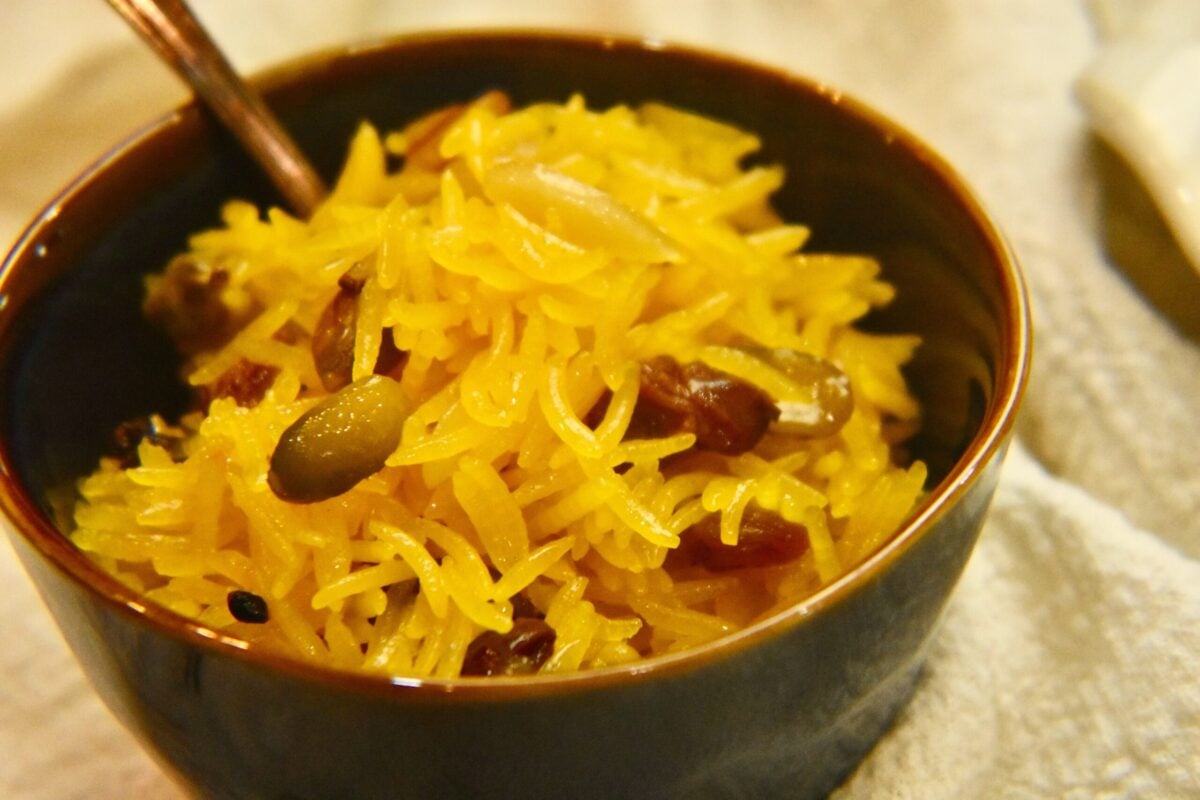
WANT TO SAVE THIS RECIPE?
In this Zarda recipe, special parboiled basmati rice is first soaked and then boiled with a pinch of food coloring to achieve its famous yellow jeweled tone. A dessert of Persian and Mughal origins, the name Zarda is actually derived from the Persian and Urdu (Pakistan's national language) word 'Zard,' which means yellow.
After being boiled, the rice is toasted in oil along with some aromatics and then layered with sugar, dry fruits, and saffron dissolved in milk for an irresistible finish. Served warm, just like carrot halwa, gulab jamun, pumpkin halwa, and sooji ka halwa, Zarda is a heartwarming dish.
Jump to:
Why you'll love this recipe
- Delicious after a spicy meal - This sweet and aromatic Zarda recipe is the perfect dessert to enjoy after eating a rich and spicy Pakistani meal.
- Perfect winter dessert - A cozy treat that's perfect for the colder months of the year, this recipe is a fall and winter favorite.
- Easy recipe - Most warm desserts that are part of Pakistani cuisine, like halwa, can take hours to make. This quick and easy Zarda recipe is on the table in 40 minutes, only 20 of which require your attention.
- Great for a crowd - Cooking a larger batch of this Zarda recipe takes no extra time, making this a great option for feeding a large crowd.
Ingredient notes
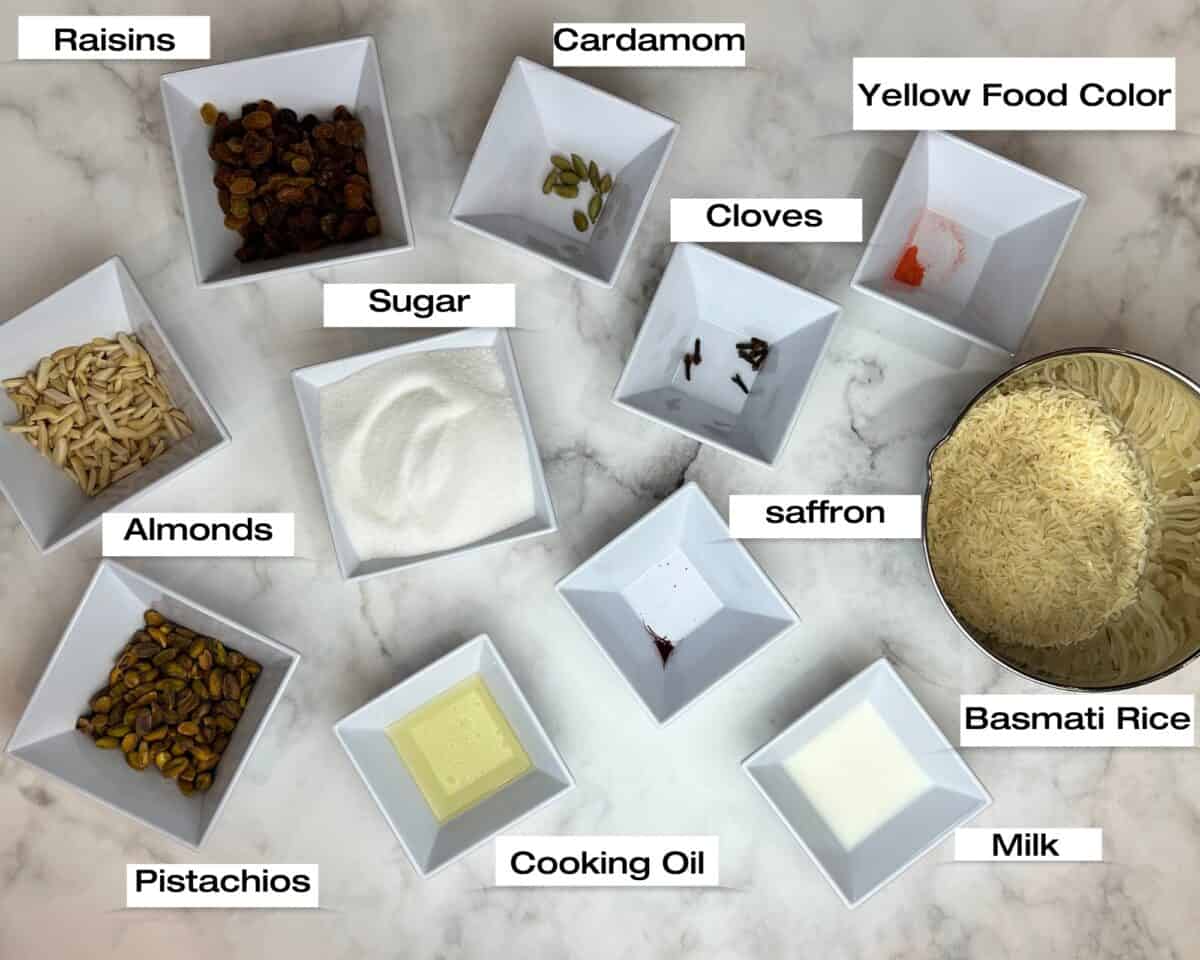
- The rice - The best rice for this Zarda recipe is Sela Rice, which is a parboiled rice with an exceptionally long grain. I like to use the Zebra brand, which is available at most South Asian stores or on Amazon, for all my cooking.
- Cooking oil - I use canola oil for my Zarda when cooking at home and ghee when cooking for a special occasion. Any other neutral, high-smoke point cooking oil, such as avocado, sunflower, or peanut, will make a great substitute for the Canola.
- Pistachios - Salted-shelled pistachios balance the sugar and add a vibrant green color to this Zarda recipe.
- Almonds - Peeled and slivered almonds add a rich taste and pair well with the pistachios.
- Raisins - Golden raisins work best for most Pakistani desserts, and once cooked, they're plump and juicy, creating a perfect contrast to the crunchy nuts.
- Food color - Yellow or orange food coloring gives this Pakistani dessert a gorgeous hue. I usually go with yellow unless I can't source it.
- Cardamom - Whole crushed cardamom is present in almost every Pakistani dessert, and this Zarda recipe is no different. I use both the seeds and husk in this dessert.
- Saffron - I also like to add a taste of saffron to my Zarda, especially when making it for a special occasion. It pairs perfectly with the cardamom and cloves, and due to the steaming process involved in this dessert, there's no need to steep the saffron separately.
Please see the recipe card at the bottom of this post for the complete list of ingredients with measurements plus recipe instructions.
Substitutions & variations
- Add khoya - Milk solids can be purchased at South Asian stores or made at home. When added to the Zarda recipe, the result is a richer, more indulgent version of the traditional dessert.
- Try tutti frutti - Colorful candied cubes made from raw papaya called tutti frutti or 'ashrafiyan' also add a mouthwatering texture, taste, and pop of color to the Zarda recipe.
- Opt for other aromatics - I like to keep it simple with cardamom, cloves, and saffron in my Zarda recipe, but a splash of kewra (screwpine) or rose water makes a pleasant change.
- Use a different fat - Try ghee or butter instead of cooking oil for this Zarda recipe, especially for a special occasion.
- Make it dairy-free - Use coconut milk instead of cow's milk to mix the saffron in at the end. In fact, if you use oil and coconut milk, the Zarda will be dairy-free and vegan.
Step-by-step instructions
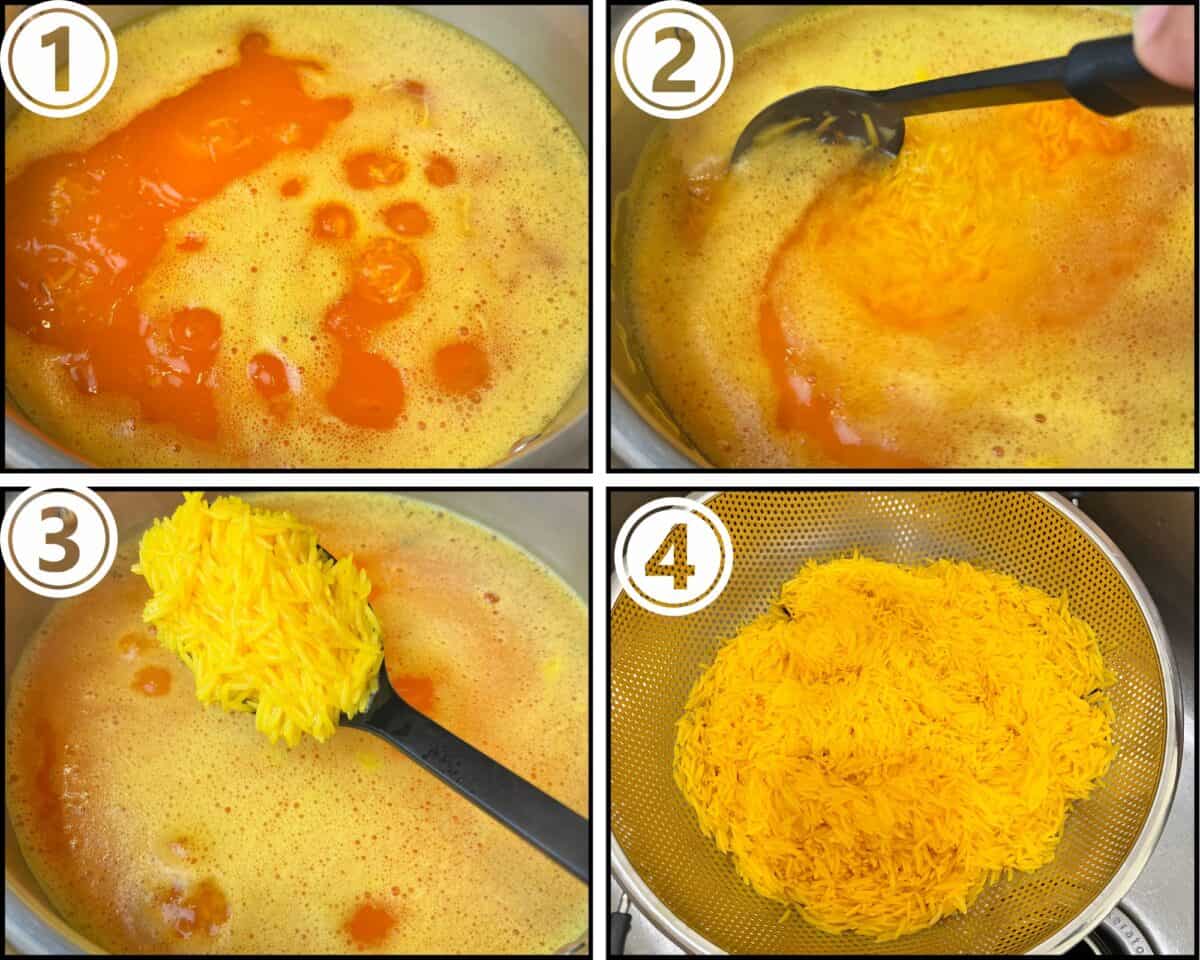
- First step - After soaking the rice for a minimum of 2 hours, add it along with 8 cups of water and the yellow food coloring to a cooking pot and bring it to a boil.
- Second step - Stir gently once to prevent the rice from clumping and cook on medium heat.
- Third step - Check the rice periodically with a slotted spoon to see if it's cooked.
- Fourth step - Strain the rice and discard the water once it is 90% - 95% cooked.
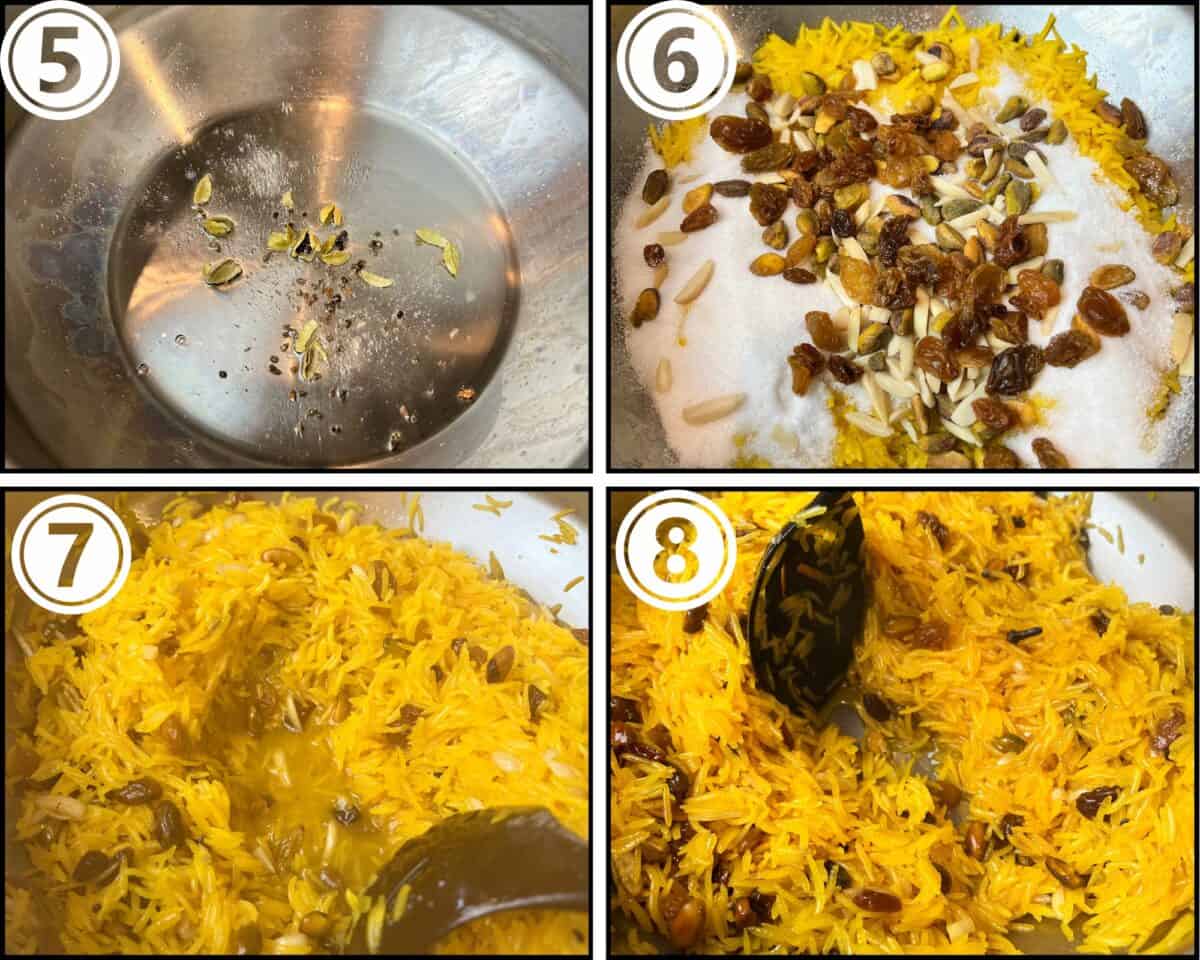
- Fifth step - Gently crush the cardamom, just enough to lightly break it apart. Heat the cooking oil, add the cardamom and the cloves, and saute until you smell the aroma.
- Sixth step - Add the cooked rice and stir it gently to coat it in the oil. Layer the sugar, nuts, and raisins on top and cover.
- Seventh step - After 5 minutes, the sugar will melt and make syrup.
- Eighth step - Stir the rice gently to coat it in this syrup.
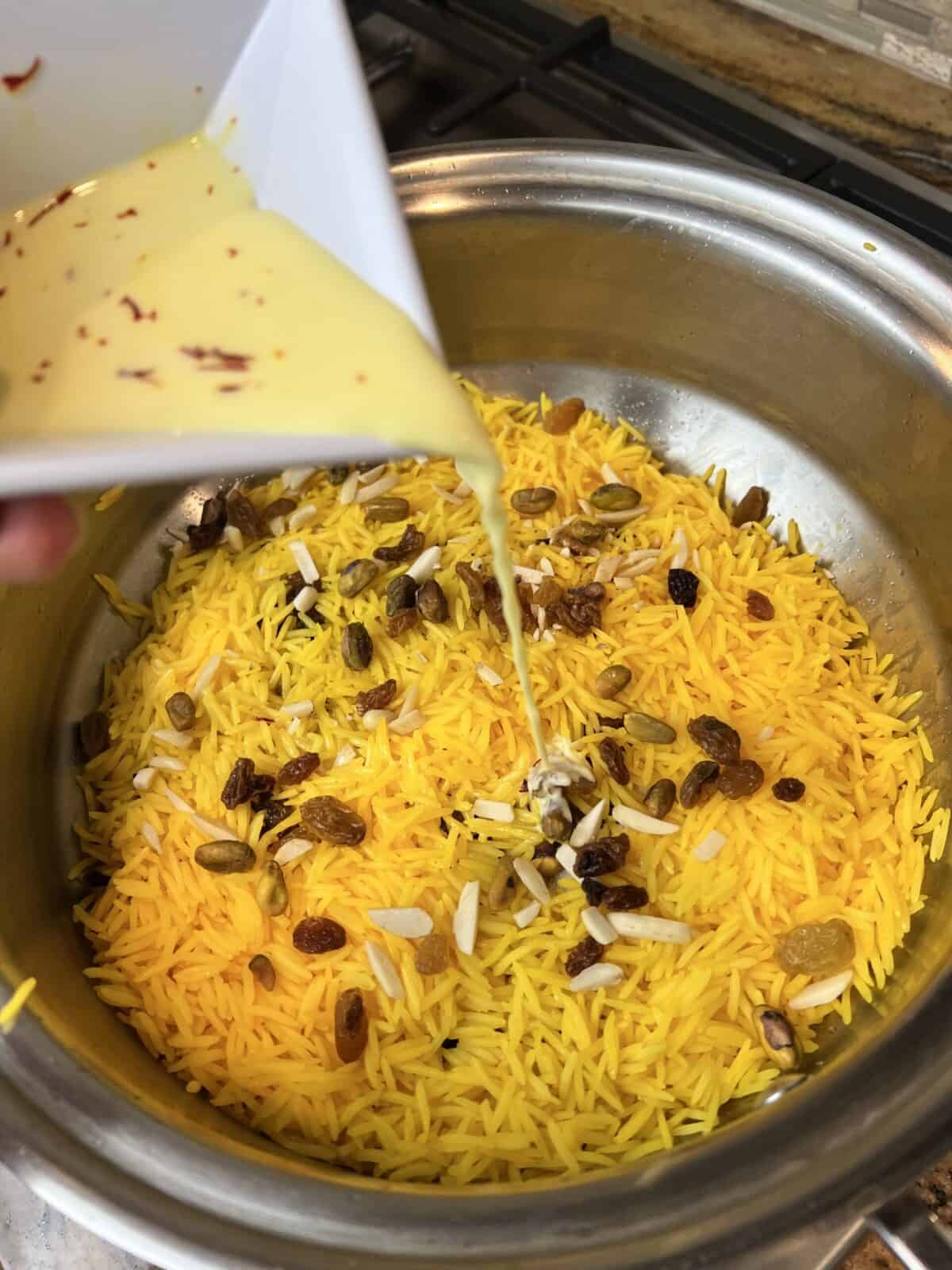

- Ninth step - Combine warm milk and saffron and pour this mixture over the rice. Cover with foil, seal tightly, and place the lid on top. Reduce the heat to the lowest setting and steam (dum) the rice for 15-20 minutes.
- Tenth step - Uncover and test the rice to ensure it's done, fluff, and serve.
Expert Tips
- Use Sela rice - It's always best to use this variety of rice for special recipes like Zarda, biryani, or mutton yakhni pulao.
- Use Ghee - To take your Zarda recipe to the next level, use ghee. The nutty taste and rich texture are perfect for this recipe.
- Roast the nuts - Toasting the nuts gives the Zarda a depth of flavor. If you have the time, I highly recommend this extra step.
- Use a tawa during 'dum' - When steaming the rice at the end, a process known as 'dum' in Pakistani cooking terminology, place a 'tawa' or skillet between the flame and the cooking pot. This will ensure that the rice at the bottom will not burn and the rice will cook to perfection.
Recipe FAQS
No. Zarda is a saffron-colored rice with dried fruits and aromatics, while Mutanjan is multi-colored rice with nuts, tutti frutti, khoya, and mithai.
Add a small amount of milk and then cover it with a lid. Let it steam for a few minutes to help the rice finish cooking.
Spread the rice as best you can into a single layer on a baking sheet. Next, reheat it in the oven at 350 degrees for about five minutes. This will dry out the excess moisture.
Store any leftover Zarda in a container with an airtight lid for 2-3 days in the fridge and for up to 4 weeks in the freezer. Reheat in the microwave with 2-3 tablespoons of water and a lid on.

Other desserts you may like
For more Pakistani recipes like this, check out 20 popular Pakistani recipes. If you decide to try this recipe, Please don't forget to leave a rating and comment below! If you take a picture then tag me on Instagram! Thank You!
Zarda Recipe (Pakistani Sweet Rice)
WANT TO SAVE THIS RECIPE?
Ingredients
- 2 cups Sela rice (see notes)
- 8 cups water
- ¼ teaspoon yellow food coloring (see notes)
- ½ cup cooking oil (see notes)
- 8 pieces cardamom
- 8 pieces cloves
- 1 ½ cups sugar
- ¼ cup salted pistachios
- ¼ cup slivered almonds
- ¼ cup golden raisins
- ¼ teaspoon saffron (see notes)
- ¼ cup milk (see notes)
Instructions
- Soak the rice for at least 2 hours and then strain it, discarding the water. (see notes)
- Add the soaked rice, 8 cups of water, and yellow food coloring to a cooking pot and bring to a boil.
- Cook the rice on high till it's almost done, about 90% done, discard the water, and set the rice aside. (see notes)
- Crack open the cardamom just enough to release the seeds and lightly smash it to release the essential oils. (see notes)
- Add the cooking oil to the pot, and saute the cardamom (husk and seeds) and the cloves on high for a minute.
- Lower the heat, add the rice, and toss it lightly in the oil.
- Top it with the sugar, followed by the nuts and raisins and cover.
- Uncover after 5 minutes and stir gently to coat all the rice with the sugar syrup.
- Warm the ¼ cup milk, add the saffron to it and pour this over the rice (see notes)
- Seal the pot with foil, cover with the lid, and make sure your heat is set to the lowest setting. (see notes)
- After 20 minutes, uncover the pot, remove the foil, gently fluff the rice and serve. (see notes)



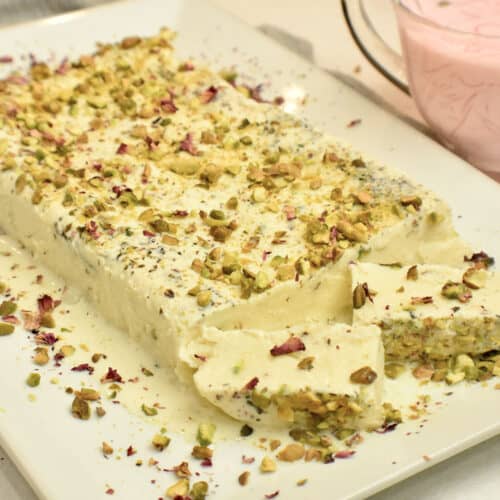
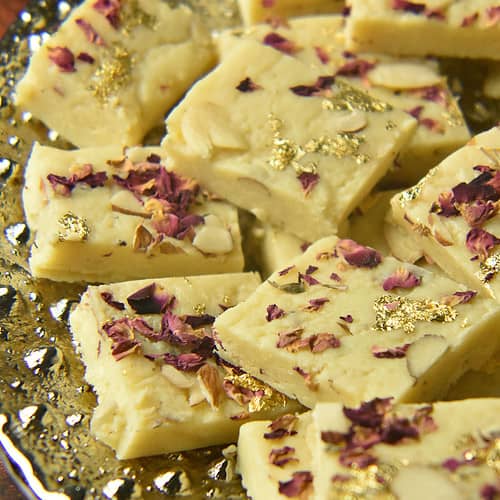

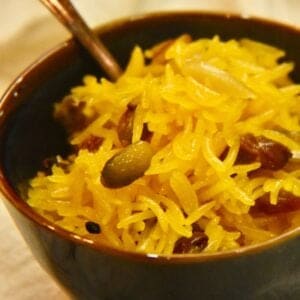

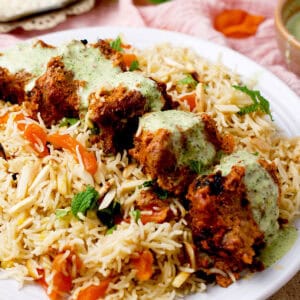
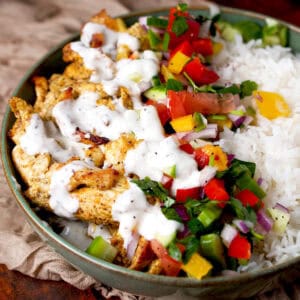
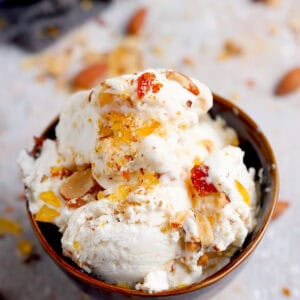
Edward Powell
One of the most delicious desserts I have ever tasted. Should be on the menu of every Indian & Pakistan restaurant in the UK. 10/10.
Nosheen Babar
Hi Edward,
I'm glad you've fallen in love with Zarda. Thank you for leaving a review.